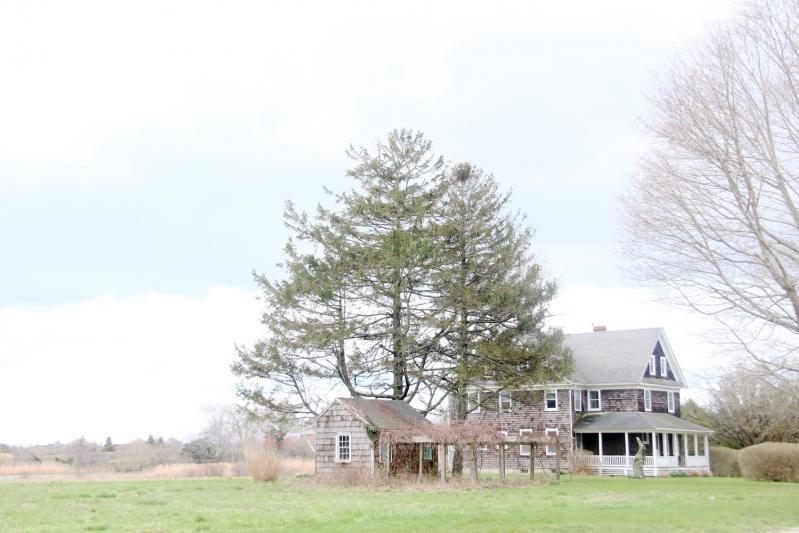Before an East Hampton Town Board hearing last Thursday on designating two structures at 66 Main Street in Wainscott as historic landmarks to be known as the John Osborn Homestead Historic Landmark, Hilary Osborn Malecki, whose family has a 350-year history on the land, shared stories about the buildings.
They sit on a 30-acre lot that the town purchased for $56 million from Ronald Lauder, “the largest warrant, we believe in the town’s history,” Supervisor Kathee Burke-Gonzalez said last Thursday.
As at the Oct. 17 public hearing for the land purchase, Ms. Osborn Malecki offered some historical context and personal recollections.
She described a hatch in the attic of the main farmhouse, where her grandfather would hoist himself up to look for whales. “Raymond was 16 when the last Wainscott whale was caught by his father in 1907, and apparently, he was always hoping for another.” Grape plants tangled over an arbor there are among the oldest plants in Wainscott. “Jelly has been made from these Concord grapes for generations.” A tiny house that had been imported to the property from Further Lane, known by family children as “the playhouse,” once housed a family of farmers, though it never had electricity or running water.
Ernest Field worked as a farmhand on the property and lived in an apartment over the garage. “On dark winter nights, it was said you could walk down Main Street and see a single light shining from the garage kitchen window. Through it you’d find Earnest sitting at the table, reading his newspaper in the warmth of the wood stove.” Unbeknownst to her until recently, teenagers, on those same dark nights, would steal gasoline from the pumps in front of the garage that serviced the farm equipment and Ms. Osborn Malecki’s family station wagon.
Louisa Edwards Osborn’s granddaughter, Amy Hunter, wrote that of all the houses she had lived in, “Her favorite view was from the small window at the top of the farmhouse stairs, where, when life was still, the view was like a 19th-century landscape painting. She would sit with her elbow on the windowsill and dream of Wainscott, where her family had lived for nearly 300 years, wresting a living from its fertile soil and occasionally turbulent sea.”
While an earlier public hearing about preserving the 30-acre lot was full of praise for the board and the acquisition, at last Thursday’s hearing, three members of the Wainscott Heritage Project, while reiterating praise for the large purchase, questioned why the land wouldn’t also be designated as a landmark along with the structures.
“The farm goes with the farmhouse,” said Esperanza Leon, the president of the Wainscott Heritage Project’s board of directors. She noted a 1990 survey of historic and architectural resources prepared by Robert Hefner that highlighted that 66 Main Street was “The only parcel remaining in historic Wainscott where the dwelling is not divided from the farmland. The Wainscott Heritage Project strongly encourages the town board to designate the entirety of the John Osborn Homestead as a historic landmark, inclusive of the three accent structures and surrounding 30 acres. The fields surrounding Wainscott Pond comprise a cultural landscape that is a significant feature of the site and is integral to the historic designation.”
Carolyn Logan Gluck, a co-secretary of the Wainscott Heritage Project, described the town’s purchase of the land as a “dream come true,” but like Ms. Leon, said she was “disturbed to hear” that only the two structures would be landmarked. “They go together, are indivisible, and compose the historic meaning of the site,” she said. “Designation of the entire parcel will be the linchpin in securing Wainscott’s historic center” and expand on the “four pillars on which Wainscott stands: the chapel, the schoolhouse, the cemetery, and the general store.”
The Wainscott Heritage Project members cited precedent for landmarking land with structures citing the Carl Fisher House in Montauk, the Ambrose Parsons House in Springs, and the Thomas Strong House, also in Wainscott. It wasn’t clear why the town board had exempted the land from the historic designation, and when David Buda, a town resident, asked for clarification, Councilman David Lys said, “I will make my intentions known in discussion if this comes to a resolution to approve.” The hearing was closed.
The board moved onto resolutions.
“This is a good series,” said Councilman Ian Calder-Piedmonte, before he read off eight notices of public hearing scheduled for next Thursday. They included three for first-time homebuyer down payment assistance, and five for Community Housing Funding Projects.”
“Heartwarming,” said Ms. Burke-Gonzalez.
--
Correction: A typo in an earlier version of this story inverted the numbers on the purchase price of the Lauder property. It was $56 million, not $65 million.




